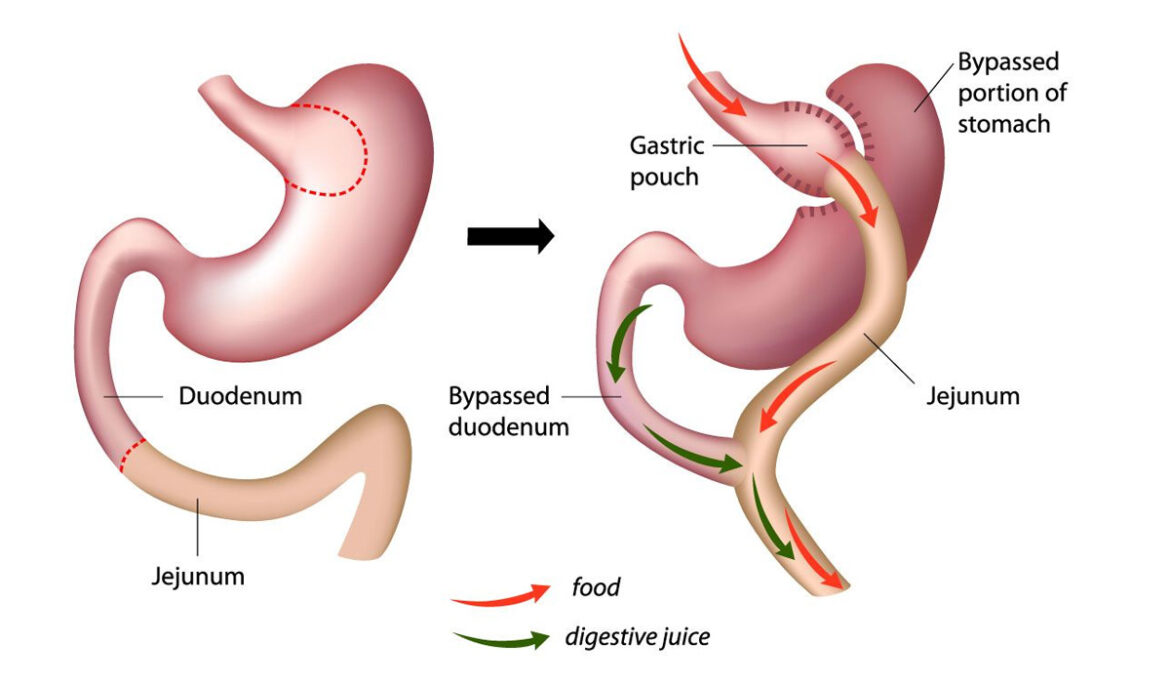What is Gastric Bypass Surgery?
Gastric bypass surgery is a type of Bariatric surgery. The procedure of gastric bypass surgery has been specifically designed for reducing the food intake for those who have failed to reduce their weight by every means.
The purpose of the procedure is to make changes in the digestive system so as to limit the consumption of food. The procedure can improve the overall quality of life not only in terms of appearance but also reduce a number of health problems that overweight people are prone to suffer like heart problems and diabetes.
Types of Gastric Bypass Surgery
Biliopancreatic Diversion Bypass: This technique is less common and where the bypass is attached to the distal illium and the portion of the stomach is removed.
Roux-en-Y Gastric Bypass: This technique is more common than Biliopancreatic diversion bypass. Roux-en-Y technique does not remove any portions of the stomach. The technique is performed with the help of open surgery by making 1 long incision. The technique can also be done laparoscopically and multiple smaller incisions are used instead of one long incision. The surgeon inserts a laparoscopic instrument in order to view the abdomen from within.
Who should consider Gastric Bypass Surgery?
- Candidates who have a BMI (Body Mass Index) of 40 or more.
- Candidates who weigh 100 pounds or more than their ideal body weight.
- Candidates who have serious health problems of heart disease and diabetes due to excess weight and who have a BMI of 35 or more.
Procedure for Gastric Bypass Surgery
- The procedure is performed under general anesthesia.
- The procedure begins by making the stomach smaller. Staples are used for dividing the stomach into two sections- a larger bottom section and a small upper section. Pouch (top section) is that part where the food eaten is stored. This pouch can hold around one ounce of food and is of walnut shape.
- A bypass is a next step. The small part of the small intestine is connected to a small hole in the pouch. The food will travel from this top section of the stomach (pouch) into the small intestine. Due to this entire process, the food will absorb fewer calories.
Mini Gastric Bypass Surgery
Mini Gastric Bypass Surgery (MGB) is a very successful, inexpensive, short and simple technique in weight loss surgery. This low-risk procedure involves minimal pain and has proved as the best procedure for long-term weight loss. The surgery cuts down the hunger by more than half in comparison to the band that leaves patients vomiting and hungry whenever they eat healthy food. The MGB procedure takes about 40 minutes to complete and involves less recovery time along with a shorter stay at the hospital. The benefits of MGB include –
- Mostly it is performed on an outpatient basis.
- Involves faster recovery.
- Lower cost as compared to other weight-loss surgeries.
- High success rate up to 70%.
Gastric Bypass Sleeve Surgery
Gastric sleeve surgery also referred to as sleeve gastrectomy, vertical sleeve gastrectomy, laparoscopic sleeve gastrectomy and sleeve resection, is regarded as the newer type of Bariatric surgery. The purpose of this surgery is to limit the amount of food that a stomach can hold. The other purpose is to remove a portion of the stomach that produces the hormone known as Ghrelin (a hormone that causes hunger). The sleeve gastrectomy is regarded as the best alternative to duodenal switch surgery or gastric bypass surgery. The procedure can also be done laparoscopically.
Benefits of Sleeve Gastrectomy
- The procedure can be performed laparoscopically.
- The procedure increases the feeling of fullness and reduces the volume of the stomach.
- The procedure is simpler than gastric bypass.
- Allows normal functioning of the stomach and the food is eaten in smaller quantities.
- The surgery involves less operative time.
- There is a comparatively less stay in the hospital as compared to bypass surgeries.
- The Ghrelin hormone is removed.
- There is no use of foreign bodies as compared to bypass surgeries.
- It does not require an intestinal bypass.
- There is no dumping syndrome due to the pyloric portion of the stomach is left intact.
Laparoscopic Gastric Bypass
The surgery is specifically designed for supporting an obese patient with weight control. From the existing stomach, a small pouch is created and is attached to the small intestine. This small pouch can hold only 1-2 ounces of food due to the reduced size of the stomach. The food then passes from this pouch and goes directly into the intestine. The pouch fills with food quickly and on the other hand, it empties gradually. A person feels satisfied even after consuming a very less quantity of food. The end result is the intake of fewer calories over the entire day that ultimately leads to weight loss in the long run.
Gastric Bypass Surgery Recovery
After the surgery, the stay in the hospital is about 2-3 days and in the case of the laparoscopic procedure, the stay is about 1-2 days. Normally, the recovery period is about 5 weeks.
Cost of Gastric Bypass Surgery
The cost of gastric bypass surgery in India depends upon the procedure chosen. The low cost of laparoscopic procedures attracts a large number of patients from across the world. All the surgeries in India are performed by trained surgeons and they also possess relevant training from developed countries.
